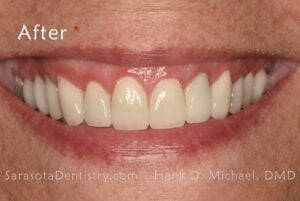
Patients dissatisfied by the color, look, or shape of their teeth might consider getting porcelain veneers. They are custom-made, thin layers of ceramic porcelain that provide a covering for the front of teeth.
Veneers can correct crookedness, stains, discoloration, chipping, and decay, thus improving the overall appearance of a patient’s smile. Veneers can also fix gaps and lengthen or shorten teeth, making them look more even and producing a natural look. Patients who experience acid reflux might also appreciate the benefits of veneers in restoring their smile.
Veneers typically require 3-4 visits to the dentist. To create a veneer, your dentist first has to mock up a design in the mouth using composite filling material. This allows the patient and the dentist to evaluate if the desired shape and color of the teeth are appropriate. After the mock up is completed, a full mouth digital impression is taken and full set of oral photos to document the accepted design. This information is then transferred to the dental lab. At the dental lab, a cosmetic dental technician then uses this data to help them design a digital wax-up of final porcelain veneers. The digital wax-up is then returned to the dentist for the veneer preparation appointment.
Veneer Preparation: In some cases, this requires no more than an impression of the teeth and is termed: No-Prep Veneers or Micro-Thin Veneers. While a traditional veneer preparation requires a very small amount of enamel removal be completed prior to the impression. The lab fabricated digital wax-up is then used to fabricate acrylic veneers in the mouth as temporary restoration while waiting on the final porcelain veneers. These temporary veneers aren’t required to stay on the teeth while you wait but they are critical to the cosmetic laboratory technician. It is critically important to take photos and an impression of the digital wax-up to share with the lab. That is the technicians blue print for the final design.
Veneer Delivery: during this visit, your dentist chemically bonds the veneer to your natural tooth. Before they are bonded, they must be tried in and verified by the patient. This is done by placing the veneers on the teeth one by one – checking and adjusting the fit. Once all of the veneers are placed on the teeth with try-in paste, the patient gives them a good examination and approval before the final bonding process begins. Once approved, they are cleaned carefully and prepared for bonding. The teeth are then cleaned, isolated and primed for bonding, removing a small amount of enamel to make enough room for the veneer. Thin resin cement is applied to each veneer prior to careful placement on the veneer to the tooth surface. All excess resin is removed prior to the application of a powerful curing light, which permanently bonds the veneer. Finally, any excess resin cement is cleaned from the teeth and veneers and the bite is checked and adjusted if necessary. The veneer placement procedure requires little to no anesthesia, making it a comfortable option for patients who worry about pain or discomfort.
Once installed, porcelain veneers require regular brushing and dental check-ups, making them relatively easy to clean and preserve. Patients who tend to grind their teeth while sleeping should wear a mouthguard (aka. TMJ Splint or Nightguard). Certain oral habits like biting nails or using one’s teeth to tear thread or open wrappers can damage veneers.
Table of Contents
Types of Veneers
Veneers vary in type, depending on the procedure a dentist uses to install them. Traditional veneers are those previously described, which involve buffing down the enamel and some of the layers underneath to accommodate the shell. No-prep veneers require less or no alteration of the original tooth and usually require no anesthetic.
Not all porcelain veneers have the same appearance. Patients can choose from 12 styles to have their teeth reflect specific characteristics.
- Aggressive—This style suits women and men who want to convey a strong personality. The design is generally square, with lateral and central incisors slightly curved or semi-straight.
- Hollywood—Some men who want a robust set of teeth without appearing too aggressive might choose this style. These teeth look similar to Aggressive, but the lateral incisors are mildly offset or shorter than the central incisors.
- Mature—This style is also similar to Aggressive, but the Mature set has slightly more pointed canines.
- Vigorous—Another style like the Aggressive, the Vigorous has more pronounced canines, almost protruding like fangs.
- Oval—The canines and incisors are more oval or rounded compared to the Aggressive.
- Softened—This style looks like the Oval, but with less curving of the tooth edges.
- Youthful—Another style similar to Oval, Youthful includes more protruding canines like the Vigorous.
- Dominant—This style has square and round central incisors and pointed canines. The lateral incisors rest a bit higher than the central incisors and have rounded far corners.
- Enhanced—Many beauty pageant contestants and female models who desire perfect-looking white teeth or photos choose this style. The Enhanced includes central and lateral incisors with slightly rounded edges, but the lateral incisors are shorter and higher than the central incisors. The canines have a blunt point.
- Focused–This style is similar to Enhanced, except that the central incisors have square edges.
- Functional–Another style like the Enhanced, the Functional has more pointed canines.
- Natural–Except for canines that are even more pointed than the Functional, the Natural style looks similar to Enhanced.
Cost of Veneers
Veneer placement might seem daunting to patients who ask, “How much do a full set of veneers cost?” Because veneers are considered cosmetic, most insurance plans don’t cover the cost. Prices for traditional veneers typically range from $1800 to $2,500 per tooth, while no-prep veneers can cost between $1700-$2,500 for each tooth. An upper smile is 8-12 teeth and a full mouth can require 20+ veneers. Many factors are considered to come up with an appropriate number of veneers needed.

Advantages of Veneers
Porcelain veneers are a suitable option for patients who want a look just as natural as their original teeth and provides a more youthful appearance. Veneers can be an excellent solution for people who want to remove teeth stains but don’t see much improvement from whitening products or procedures. Compared to bonding, veneers tend to last longer and provide a more consistent color over time than bonding. Veneer surface texture and wear resistance are also superior to bonding.
As stated earlier, veneers take little more than regular oral care, such as brushing, flossing, and regular dental check-ups. While the procedure itself is not very invasive, it is time consuming in order to achieve optimal results. Therefore, you may be more comfortable working with a cosmetic dentist that offers oral or I.V. Sedation to perform the procedure. Sedation is not required but can make each visit much more comfortable.
Disadvantages of Veneers
One downside of porcelain veneers is that placing them requires more than one visit to the dentist. That’s because, after producing the mold, the dentist has to send that mold to a dental lab where a technician creates it. Patients have to go back to the dentist to have the veneers attached. However, this is not always true if the patient is seeing a CEREC dentist that offers same-day veneers.
Once you get veneers, you cannot go without them. Veneer placement is permanent because the dentist has to remove a bit of the enamel from the original tooth to fit the attached layer. Once you lose that enamel, you can’t get it back. However, if you have prep-less, no-prep or micro-thin veneers, the procedure is reversible.
Additionally, a set of veneers won’t last forever. Most shells are designed to last up to 15 years, but some patients can wear them for as many as 30. However, patients should expect to plan to replace them.
Although veneers consist of very strong material, they’re not damage-proof. It’s possible for veneers to chip or crack, which is why caring for them is important.
- Dental Implant Pros and Cons - August 26, 2023
- Receding Gums Stages - August 12, 2023
- When Is It Too Late for Gum Grafting? - July 8, 2023


